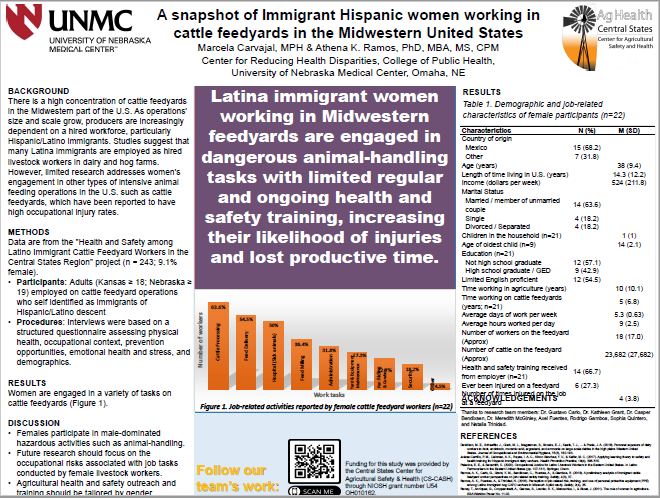A snapshot of Immigrant Hispanic women working in feedlots in the Midwest of the U.S.
Marcela Carvajal-Suarez, MPH and Athena Ramos, PhD, MBA, MS, CPM, University of Nebraska Medical Center
b.carvajalsuarez@unmc.edu
Marcela Carvajal is an Outreach Project Specialist at the University of Nebraska Medical Center, College of Public Health, Center for Reducing Health Disparities, in Omaha, Nebraska. She is part of a Latino outreach and engagement team that focuses on community-based health research and education initiatives in areas such as agricultural health and safety, immigrant integration, and community well-being. Dr. Athena Ramos is an Assistant Professor in the Department of Health Promotion and is affiliated with the Center for Reducing Health Dis¬parities and the Central States Center for Agricultural Safety and Health (CS-CASH) at the University of Nebraska Medical Center (UNMC) in Omaha, Nebraska. She leads a Latino outreach and engagement team and serves as principal investigator for a number of community-based health and social research and education initiatives in such areas as agricultural health and safety, immigrant integration, and community well-being.
Discuss this poster with the authors on Tuesday, November 9 from noon – 12:30 on the Zoom Live-stream.
The production and commerce of livestock have grown rapidly worldwide to supply consumers and export markets. Women’s role in small-scale livestock production is well recognized globally; however, women are an essential but underrepresented part of the agricultural workforce in the United States. Recent studies suggest that many Latina immigrants are employed as hired livestock workers in dairy and hog farms. Limited research addresses women’s engagement in other types of intensive animal feeding operations such as cattle feedyards, an occupation with high occupational injury rates. We used data from the “Health and Safety among Latino Immigrant Cattle Feedyard Workers in the Central States Region” project (n = 243; 9.1% female) to describe demographic characteristics, job-related activities, and safety and health opportunities of female feedyard workers in the Kansas and Nebraska. Most women were from Mexico (68.2%), had spent about 5 years (SD 6.8) working in feedlots, and reported an average of 4 injuries (SD 3.8) in that period of time. Latina immigrant feedyard workers are engaged in animal-handling tasks with limited regular and ongoing health and safety training. We discuss occupational risks associated with job tasks and suggest tailored opportunities to engage female agricultural workers to improve health and safety.
|
|


